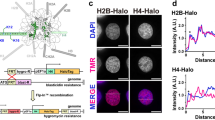Abstract
The synaptonemal complexes in pollen mother cells (PMCs) of rye in which one chromosome 1R was replaced by the two corresponding telocentrics, and where one additional telocentric 1RS was present, showed approximately the expected 2∶1 ratio of 1R-1RL-1RS trivalent with 1RS univalent versus heteromorphic 1R-1RL bivalent with 1RS bivalent. In addition, however, many cells with a partner exchange were found, several even including bivalents other than 1R. At metaphase I1R-1RL-1RS trivalents predominated, cells with two univalent telocentrics were relatively frequent but partner exchange configurations were extremely rare. It is concluded that the almost consistent failure to form chiasmata in the interstitial region of 1RS after partner exchange, combined with much more frequent chiasma formation in the terminal segment, is the main reason for the unexpected metaphase I configuration frequencies. Possible causes are discussed. The shift observed does not yet explain the erratic variation in relative frequencies of metaphase I configurations reported earlier in similar material. Frequent pairing partner exchange may play a role there also.
Similar content being viewed by others
References
Abirached-Darmency M, Zickler D, Cauderon Y (1983) Synaptonemal complex and recombination nodules in rye (Secale cereale). Chromosoma 88:299–306
Elçi S, Sybenga J (1976) Incomplete preferential pairing in a tetraploid Secale hybrid carrying translocations: multivalent configuration frequencies and marker segregation. Genetica 46:177–182
Gillies CB (1985) An electron microscopic study of synaptonemal complex formation at zygotene in rye. Chromosoma 92:165–175
Gillies CB (1987) Genetic and cytogenetic analyses of the A genome of Triticum monococcum. IV. Synaptonemal complex formation in autotetraploids. Genome 29:309–318
Giraldez R, Cermeno MC, Orellana J (1979) Comparison of C-banding pattern in the chromosomes of inbred lines and open pollinated varieties of rye. Z Pflanzenzuecht 83:40–48
Hobolth P (1981) Chromosome pairing in allohexaploid wheat var. Chinese Spring. Transformation of multivalents into bivalents, a mechanism for exclusively bivalent formation. Carlsberg Res Commun 46:129–173
Holm PB (1986) Chromosome pairing and chiasma formation in allohexaploid wheat, Triticum aestivum, analyzed by speading of meiotic nuclei. Carlsberg Res Commun 51:239–294
Jenkins G (1983) Chromosome pairing in Triticum aestivum cv. Chinese Spring. Carlsberg Res Commun 48:255–283
Jenkins G (1985) Synaptonemal complex formation in hybrids of Lolium temulentum x Lolium perenne (L.). II. Triploids. Chromosoma 92:387–390
Jenkins G (1986) Synaptonemal complex formation in hybrids of Lolium temulentum x Lolium perenne (L.). III. Tetraploids. Chromosoma 93:413–419
Jong JH de, Eden J van, Sybenga J (1988) Synaptonemal complex formation in a translocation heterozygote of rye (Secale cereale L.). Genome, in press
Loidl J, Jones GH (1986) Synpatonemal complex spreading in Allium. I. Triploid A. sphaerocephalon. Chromosoma 93:420–428
Naranjo T, Orellana J (1984) Meiotic behaviour of chromosomes 1R, 2R and 5R in autotetraploid rye. Chromosoma 89:143–150
Neijzing MG (1982) Chiasma formation in duplicated segments of the haploid rye genome. Chromosoma 85:287–298
Neijzing MG (1985) Number and localization of sets of homolo- gous segments in the genome of rye on the basis of giemsabanded metaphase. I. Chromosome associations in a haploid. Genetica 66:41–52
Parker JS (1987) Increased chiasma frequency as a result of chromosome rearrangement. Heredity 58:87–94
Rasmussen SW, Holm PB (1979) Chromosome pairing in autotetraploid Bombyx females. Mechanism for exclusive bivalent formation. Carlsberg Res Commun 44:101–125
Sybenga J (1966) The zygomere as hypothetical unit of chromosome pairing initiation. Genetica 37:186–198
Sybenga J (1969) Allopolyploidization of autopolyploids. I. Possibilities and limitations. Euphytica 18:355–371
Sybenga J (1972a) Localisation of intraspecific variation in meiotic chromosome pairing. Chromosomes Today 3:104–109
Sybenga J (1972b) Chromosome-associated control of meiotic pairing differentiation. Variation within Secale cereale. Chromosoma 39:351–360
Sybenga J (1975) Meiotic configurations. Springer, Berlin Heidelberg New York
Sybenga J (1976) Quantitative variation in chromosome pairing affinities within a species, Secale cereale. In: Jones K, Brandham P (eds) Current chromosome research. North Holland, Amsterdam, pp 143–150
Author information
Authors and Affiliations
Rights and permissions
About this article
Cite this article
Qi, L.L., Sybenga, J. & de Jong, J.H. Synaptonemal complex pairing and metaphase I association in a telo-substituted telotrisomic of rye (Secale cereale L.). Chromosoma 97, 88–95 (1988). https://doi.org/10.1007/BF00331798
Received:
Revised:
Issue Date:
DOI: https://doi.org/10.1007/BF00331798




